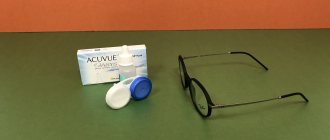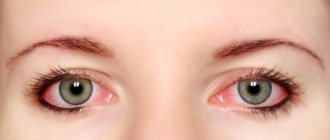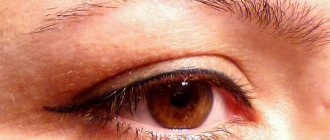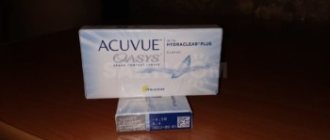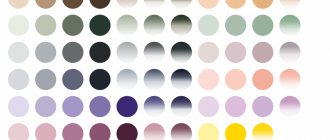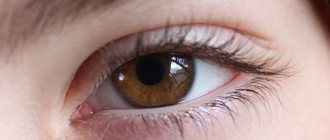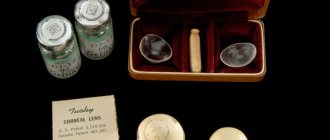How long can you wear an SCL without replacement?
Contact lenses are made from the finest material.
It is absolutely smooth, transparent, soft, does not cause allergic reactions or rejection. But the porous hydrogel quickly absorbs mineral salts, fats, and proteins that are present in the tear fluid. In addition, small scratches may appear on its surface during operation. Depending on the strength and absorbent abilities of the material, contact correction products can be divided into several groups:
- traditional (requires replacement after 6-9 months);
- quarterly (requires replacement after 3 months);
- planned (require replacement every 2-4 weeks);
- daily lenses (need to be changed every day).
Depending on the characteristics of the material from which the SCLs are made, there are also different wearing modes:
- Day. Provides for the use of lenses during wakefulness for up to several hours a day. But before going to bed, they must be removed and cleaned.
- Flexible. Allows you not to remove your lenses before bed for several days (no more than 1-2 days in a row).
- Extended. Allows you to use lenses for 1-4 weeks without removing them. Due to the high risk of developing eye infections, continuous wearing is not recommended by ophthalmologists.
Violation of the wearing regime of SCLs has no less negative consequences than their untimely replacement. Therefore, manufacturers’ recommendations must be strictly followed if you value the health of your eyes.
Makes and models
Determine for yourself which monthly lenses are best, taking into account your characteristics and wishes. In order for you to better navigate the brands presented, we consider the features of the most popular and high-quality manufacturers. Also in the summary table you can see how much monthly lenses cost for each company described.
| Name | Price | pros | Minuses | Peculiarities |
| Air Optix Aqua (Alcon company) | from 800 rubles per package with 3 pairs and from 1400 with 6 pairs | • high breathability; • resistance to pollution; • high degree of moisture. | • rigidity; • long period of adaptation. | breathable |
| PureVision 2 HD (Bausch + Lomb) | from 750 rubles for 3 pairs and 1200 for 6 pairs | • use at night; • high breathability; • resistance to the formation of plaque and dirt. | • may cause a feeling of dryness; • do not absorb glare well. | ultra-thin |
| Biofinity (CooperVision company) | the price for 3 pairs starts from 1250 rubles, for 6 pairs – from 2200 rubles | • optimal for sensitive eyes; • wide refractive range; • possibility of different diopters for the left and right eyes. | do not provide UV protection | can only be worn continuously for a week |
| Acuvue (Acuvue Oasys with Hydraclear Plus) | from 900 to 3500 rubles per package | • provide protection from ultraviolet radiation; • resistant to damage. | Continuous wearing is prohibited | high degree of moisture |
| Freshlook (FreshLook Colors company) | from 750 rubles (package includes 2 products) | • presence of an ultraviolet filter; • high humidity; • possibility of changing eye color; • hypoallergenic. | • not suitable for light eyes; • difficulties when putting on. | Must be removed at night |
What happens if you wear lenses longer than expected?
The contact method for correcting impaired visual acuity is not cheap. Therefore, in pursuit of savings, many people try to use SCLs without replacement for as long as possible. But few people know why it is better not to violate the manufacturer’s recommendations and what will happen if you wear lenses longer than prescribed.
SCLs, on the surface of which a large amount of deposits have accumulated, can cause harm to the organs of vision. If the lens replacement period is not met, there is a risk of developing ophthalmological diseases:
- Conjunctivitis. Inflammation of the conjunctiva caused by viruses and microbes that settle on the surface of the hydrogel. If left untreated, it develops into a chronic form.
- Corneal edema. When worn for a long time, the hydrogel loses its ability to transmit oxygen. This leads to compression and swelling of the cornea, blurred vision. In this case, the patient needs treatment aimed at restoring the cornea.
- Keratitis. When wearing SCL for a long time, the cornea becomes susceptible to irritants, microcracks appear on its surface, which contributes to the development of inflammation. If left untreated, the inflammatory process affects large areas of tissue, which can lead to loss of vision.
During treatment, patients are usually transferred to glasses, but after final recovery they can again use contact methods of vision correction. Many patients are interested in whether it is possible to wear lenses longer than prescribed if they have not been used for some time due to illness.
With one voice, ophthalmologists declare their categorical no. After treatment, it is imperative to change the lenses, since even many hours of disinfection in a solution is not able to remove bacteria and infections from their surface. Continued wearing of the product may lead to re-infection.
Definition of two-week lenses
Two-week contact lenses are a type of corrective optics that must be replaced every 14 days from the moment the blister is opened. This type of contact lenses is an intermediate link between daily replacement and monthly replacement products. It has a more affordable price than daily replacement lenses, but it turns out to be much more comfortable to wear than samples that should be changed once a month.
The presented type of lenses is considered one of the most convenient in terms of use. This is where it is recommended to start for those who have just started wearing contact optics.
Can the service life of SCLs be reduced?
Not in all cases, regular and colored lenses last as long as stated by the manufacturer. There are factors that can significantly accelerate the aging of the material and bring the planned replacement of SCL closer. Among them:
- hairsprays;
- cigarette smoke;
- evaporation of nail polishes;
- reuse of solution;
- insufficient removal of deposits.
Any infection makes the lenses unsuitable for further use. Their pathogens quickly settle and multiply on the surface. Even high-quality disinfection with a solution is not capable of destroying pathogenic microflora, so such SCLs can only be thrown away.
Terms of use
The period of use of this type of optics should be counted from the moment the blister with lenses breaks, and not from the date of their purchase. After opening the package, such products must be stored in a special container filled with a disinfectant solution (the only exception is extended-wear lenses). You need to put on regular daytime lenses in the morning. First, you should wash your hands well, then place the lens on your index finger, pull the eyelid with two fingers of the other hand and place the lens on the mucous membrane. After this, you will need to blink several times to get the optics into place.
You need to remove the lenses 8 hours after putting them on (or earlier if you are just starting to wear such optics - in this case, reduce this interval to 4-5 hours). To do this, you will need to carefully slide the lens towards the edge of the eyelid, and then pick it up with two fingers.
There is no need to use special tweezers for such lenses. The fact is that this type of optics is quite thin, and you risk simply tearing it when handling it with such a tool.
Contact vision correction and dry eye syndrome
If you wear lenses for longer than expected, xerophthalmia or dry eye syndrome may develop. When wearing SCLs, oxygen is supplied to the cornea due to the moisture present in their composition. The lens material itself does not have sufficient oxygen permeability. There are no blood vessels in the cornea, so it receives the necessary nutrients from its own tear fluid.
As the moisture evaporates, you may experience a feeling of dryness, foreign matter, or sand. Sometimes rapid visual fatigue and blurred vision are observed. If SCLs not intended for continuous wear are used for more than 10-12 hours in a row, corneal hypoxia may develop. This threatens a decrease in visual acuity and corneal edema.
Features of wearing and care
Each manufacturer sets certain requirements for how to wear lenses. For persons requiring constant correction, flexible and prolonged wearing modes are recommended. In any case, optics with frequent replacement do not require enzymatic cleaning. It is developed using a special technique that guarantees antiseptic properties for 14 days.
Some lenses are worn continuously throughout the expiration date after opening the blister. Such a pair of lenses is usually simply disposed of at the end of their use.
If wearing is carried out only during the day, then solutions and containers are purchased for storage. A special feature of the product is the need to purchase special liquids for periodic cleaning. During their short service life, a film of protein and fat deposits does not have time to form on the surface of the lenses. For disinfection, it will be enough to buy a multifunctional solution for storing optics.
How to make wearing SCL comfortable?
Many patients who use contact lenses are recommended to take Delfanto® capsules as a preventive measure for dry eye syndrome. This is an innovative drug based on the patented MaquiBright® extract. It contains a record amount of antioxidants – 35%.
Delfanto® capsules restore cells of the lacrimal glands, stimulate the production of natural tears and improve its quality. Within a month they eliminate the manifestations of dry eye syndrome by 45%.
The drug has a convenient release form - capsules of 30 and 60 mg. It can be used in conjunction with tear drops to improve the comfort of wearing contact lenses. 2-3 weeks after starting the Delfanto® course, you will be able to completely abandon ophthalmic solutions, while the comfort of wearing SCLs will remain until the end of their service life.
How are they different from daily and monthly?
When comparing optics in terms of replacement frequency, one wonders which lenses are safer and more convenient compared to biweekly lenses—one-day or monthly.
One-day ones guarantee sterility and high hydration. But their price is much higher, because... Every day we need a new pair.
Monthly analogues are made more dense, which is why they have less gas permeability. And they must be cleaned once every 7 days with a special composition in order to use them for 30 days without danger. But using them is much more economical.
Maintaining hygiene
To ensure that wearing such lenses does not cause you any problems, it is extremely important to follow general hygiene recommendations for their use . They provide:
- Wash your hands thoroughly before handling optics. This rule even applies to cases where the patient accidentally falls out of one of the lenses and needs to put it back in place.
- Using only specialized products for lens care: special solutions, drops, etc. It must be remembered that this type of optics cannot be rinsed in ordinary running water.
- Timely replacement of lens storage solution. It should be remembered that the old solution is an ideal environment for the growth of bacteria.
- Strictly individual use of such products. It is important to remember that such optics should under no circumstances be handed over for wearing or even trying on to any other person. This rule applies even to close relatives.
- Careful use of cosmetics when wearing lenses. It is extremely important to ensure that such cosmetics do not get on the optics themselves, otherwise they will have to be replaced.
- Compliance with wearing optics. Use lenses for no more than two weeks with mandatory removal before going to bed (if this is provided for by the type of optics you have chosen).
Violation of the presented rules can lead to infection in the mucous membrane of the eye . Because of this, a person may develop a fungal, viral or bacterial disease that requires long-term treatment.
For whom are they intended?
Despite all the positive aspects in the description of monthly lenses, they can only be used after consultation with an ophthalmologist, who will select the appropriate option for you and give individual recommendations.
If there are no medical contraindications, then monthly lenses are very convenient for the following categories of users:
- People with irregular work schedules or long shifts, when it is not possible to remove daily lenses or replace daily ones (doctors, truck drivers, conductors, emergency services employees, etc.).
- Small children and elderly people who cannot remove them on their own (due to inability, forgetfulness, underdeveloped or impaired motor skills).
- Teenagers and young people who walk around for days.
- Travelers who do not have constant necessary sanitary and hygienic conditions to replace lenses.
- Other categories of people who, for whatever reason, cannot often change lenses on their own because they fall, tear or get lost when replaced.
Features of contact lenses for eyes for a month
Planned replacement lenses for 1 month are suitable for both beginners and experienced people. This type of hydrogel CL is resistant to tearing and wear, has special oxygen conductivity and clear visibility (over this period of wear, protein deposits do not have time to accumulate).
Within their category, these products are divided into several types: by type of wear (daytime and continuous wear) and by purpose (adjustment and presence of diopters, color, tint).
The price of products depends on the manufacturer and the specific model. The consumer can choose lenses of any optical power, color or fancy, with protection from UV rays.
Tips for choosing lenses
The selection of contact lenses begins with collecting information about the patient (age, profession, diseases, etc.). A near and far vision test is then done. To test far vision, special tables or a sign projector are used. And for the neighbor - a table with text. In addition to these tests, others can be used. After this, objective refraction is determined using an autorefractometer. And with the help of trial lenses - subjective refraction.
Next, the parameters of the cornea are measured using an ophthalmometer or autorefractometer, and eye biomicroscopy using a slit lamp. If during the examination the doctor finds any contraindications to the use of lenses, then appropriate therapy is prescribed, after which the selection of lenses can be continued. If there are no contraindications, then the ophthalmologist selects the type of lenses, wearing regimen, and replacement period.
After this, the optical power, radius of curvature and lens diameter are calculated. And special disposable diagnostic lenses are tried on.
Clear Lab is one of the most sought after manufacturers
